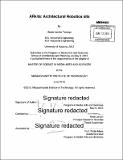| dc.contributor.advisor | Kent Larson. | en_US |
| dc.contributor.author | Larrea-Tamayo, Hasier | en_US |
| dc.contributor.other | Massachusetts Institute of Technology. Department of Architecture. Program in Media Arts and Sciences. | en_US |
| dc.date.accessioned | 2015-09-17T19:00:39Z | |
| dc.date.available | 2015-09-17T19:00:39Z | |
| dc.date.copyright | 2015 | en_US |
| dc.date.issued | 2015 | en_US |
| dc.identifier.uri | http://hdl.handle.net/1721.1/98627 | |
| dc.description | Thesis: S.M., Massachusetts Institute of Technology, School of Architecture and Planning, Program in Media Arts and Sciences, 2015. | en_US |
| dc.description | Cataloged from PDF version of thesis. | en_US |
| dc.description | Includes bibliographical references (pages 115-117). | en_US |
| dc.description.abstract | Urban space is too valuable to be static and unresponsive. Our cities are in urgent need of new architectural solutions that maximize space efficiency and respond to the complexities of life. What if the traditionally passive spatial elements, that give shape to our architectural spaces, could become dynamic and connected?What if furniture could have superpowers? In this thesis we explore a future where desks can robotically move and transform, walls can be customized and serve as a hardware platform to integrate state of the art sensor technologies, beds can become a smart home hub, closets can communicate and support new functionalities, spatial elements are finally part of the Internet of Things and the home, the office, the hotel room becomes programmable. A new generation of architectural spaces is envisioned, in which heavy furniture is moved as if it was weightless and new functionalities can be programmed with downloadable apps. In order to make this vision a reality, a new engineering toolkit is proposed, a kit of parts that allow architects and designers to create this kind of multifunctional and responsive spaces. ARkits present the framework for a new robotic genre: a hardware-software platform and modular system to create a scalable strategy for a new generation of spaces that are efficient, experiential and fun. The home of the future is not a single design, but rather a platform. | en_US |
| dc.description.statementofresponsibility | by Hasier Larrea-Tamayo. | en_US |
| dc.format.extent | 124 pages | en_US |
| dc.language.iso | eng | en_US |
| dc.publisher | Massachusetts Institute of Technology | en_US |
| dc.rights | M.I.T. theses are protected by copyright. They may be viewed from this source for any purpose, but reproduction or distribution in any format is prohibited without written permission. See provided URL for inquiries about permission. | en_US |
| dc.rights.uri | http://dspace.mit.edu/handle/1721.1/7582 | en_US |
| dc.subject | Architecture. Program in Media Arts and Sciences. | en_US |
| dc.title | ARkits : architectural robotics kits | en_US |
| dc.title.alternative | Architectural robotics kits | en_US |
| dc.type | Thesis | en_US |
| dc.description.degree | S.M. | en_US |
| dc.contributor.department | Program in Media Arts and Sciences (Massachusetts Institute of Technology) | |
| dc.identifier.oclc | 920475168 | en_US |
